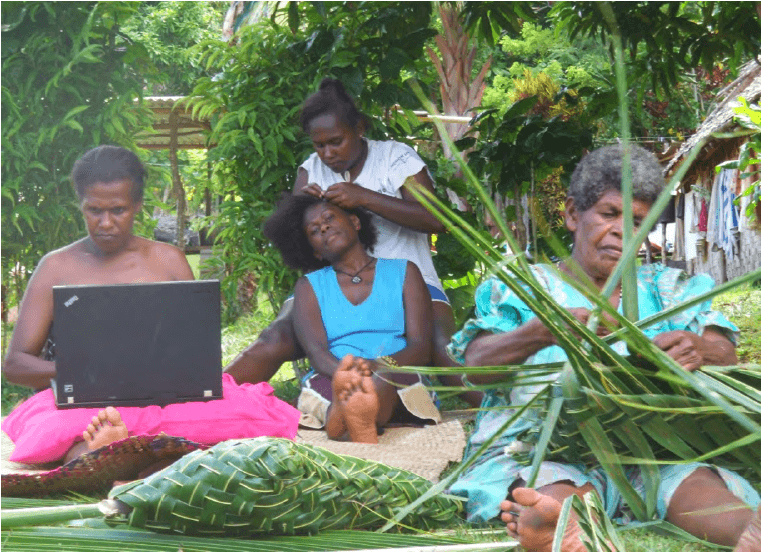The Internet in the Pacific is going through some heavy changes. The region has gone from being covered by a single satellite a decade ago to having 10 of its countries, many of them in the South, going online via undersea cables. Indeed, more submarine fibre-optic cables are being deployed in the Pacific these days than in any other region in the world—a development that is driving capacity expansion in many of its island nations. The outcomes are evident in countries like Tonga, which witnessed a five-fold increase in its Internet use within six months of its first submarine cable becoming operational in 2013.
Investment in network infrastructure has for the large part been accompanied by slew of new measures and reforms, from telecoms sector liberalisation to national broadband policies. All these have resulted in stronger competition among operators and service providers, reduced Internet prices and an overall growth in Internet uptake, mainly in mobile broadband.
Such progress also means that Pacific countries do not have to look far for good models. Vanuatu, a frontrunner in the region, has a universal access policy that aims to equip 98% of the population with Internet access within three years, partly by enforcing geographically uniform pricing throughout its many islands. Using a pay-or-play approach for carriers and ISPs, it will also start to require its state ministries to allot 3%-5% of their budget for their own ICT programmes in line with its e-government agenda.
Fiji is another bright spot. After much of the Pacific moved to satellite-based communications, radio frequency management lapsed in many countries, leaving them at a disadvantage amidst the explosion of mobile technologies. From 2011-2013, Fiji overhauled its spectrum allocation scheme, ensuring that proper band planning, standards, and technical parameters are in place. Until then, it had no commercial pricing strategy and often bundled spectrum with operating licenses. It subsequently held a manual 4G spectrum auction, priced low enough to leave operators with sufficient capital for infrastructure roll outs. Winning comes with coverage obligations for 80%-95% of the population, but also with incentives, which includes 5%-40% licensing fee rebates should operators exceed these requirements. The impact was immediate: Mobile broadband subscriptions have risen 10-fold from 2011 to 2014, and 21 out of the 40 localities under the universal service programme are now being served by ISPs.
But there’s a lot more to be done. An estimated 40% of the population in the Pacific has yet to gain access to decent quality broadband. Despite a mobile penetration of 80% or more in countries like Vanuatu, mobile broadband adoption continues to be low, at 10% or less in many island states as of 2013 according to the ITU. Fixed broadband take-up is lower, with only New Caledonia, French Polynesia, Tuvalu and Palau having more than 5% of their total population on a wired connection.
Cost remains a big barrier to adoption. Data from Network Strategies show that in most island nations in the region, subscribers spend 10%-20% or more of their average monthly income on mobile data services—more than double the UN target of 5% or less. Mobile data is currently most affordable in Fiji and the Cook Islands, but it must also be noted that these countries have a higher average income relative to others.
As it stands, the region’s average broadband speed as of 2013 was 1Mbps—a big leap from the 256kbps average some seven years ago, but still far below the 4Mbps global benchmark—and certainly insufficient to develop and access high-bandwidth applications that can address socio-economic needs.
Those how have succeeded in laying down undersea pipes are now confronted with the challenge of onward connectivity: expanding both the coverage and capacity of their domestic networks. Many of the delegates at last week’s 8th APT Policy and Regulatory Forum for the Pacific spoke of connectivity gaps, particularly for the last mile, which has yet to match the international bandwidth made available by the cables. Such upgrades must be taken into account even in the early stages of cable deployment.
Network redundancy is also a growing focus, with second cables planned for Tahiti, Tonga, New Caledonia and Papua New Guinea. These should not only make Internet access more dependable, but also enable them to carry out ICT programmes in areas like education, agriculture and ecommerce. For instance, Samoa’s newest cable, set to go live in 2016, is expected to improve remote medical diagnosis in the islands—crucial for many Pacific countries that lack advanced healthcare facilities and often need to fly citizens abroad for treatment.
Others are dealing with more fundamental issues. Solomon Islands, along with Tuvalu, Tokelau, Kiribati and Nauru, continues to rely on connectivity via satellite. The nation of some half a million people has a 21% Internet penetration rate—almost exclusively through mobile–and 98% of it is in urban areas. It cites political, economic and even cultural barriers to further connectivity, among them confused licensing guidelines in the provinces, influence peddling among vendors, and disputes over customary land that could be used as cable landing points. The country’s rough topography also experiences high rainfall, which causes further latency for transmission via satellite.
Many of the smaller Pacific nations have yet to secure adequate supporting infrastructure, such as roads and reliable power, which dissuades private sector investment. Yet another deterrent is the absence of comprehensive ICT frameworks. Guarantees for online privacy and data protection are missing in most countries, and while nearly all have national ICT policies in place, only two have implemented them. ICT readiness and security are likewise piecemeal. To date, much of the region has yet to transition to IPv6. Its Computer Emergency Response Team, PacCERT, is currently on hiatus, and only four countries thus far are working towards setting up national CERTs.
From the discussions at last week’s Pacific ICT Ministerial and Officials’ Meeting in Nuku’alofa, Tonga, it is clear that Pacific island nations continue to suffer from a dearth in resources. While multilaterals like the World Bank and the Asian Development Bank have been backing projects in the region, not all countries are currently eligible for funding, and others face difficulties in meeting donor conditions. Local expertise is another constraint. Governments at the conference underlined the need to cultivate not only digital literacy and technical know-how, but the skills—legal, financial, entrepreneurial–necessary to build up and maintain ICT systems.
The Pacific Regional ICT Strategic Action Plan (PRISAP) provides a glimpse of the region’s priorities for the next five years. Set to succeed the 2010 Framework for Action for ICT Development in the Pacific, it is currently under review by member countries and should be finalised in time for its implementation in 2016. The framework, whose target areas range from basic concerns like institutional capacity-building to more forward-looking ones like ICTs for disaster management, perhaps sums up Internet development in the Pacific as a whole—varied and uneven in places, but grounded on common concerns, indicating that the region, while it may easily be seen as a homogenous landscape, is really home to 22 nation states whose needs are just as diverse as any in the world.
Photo credit: Nguna Mamas

